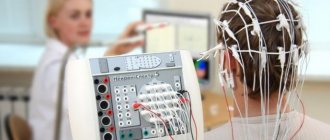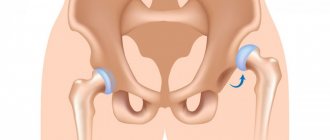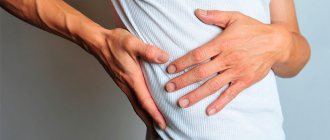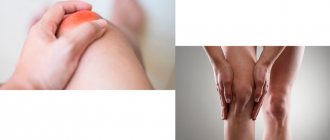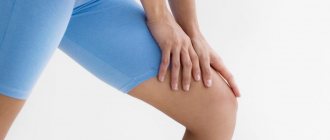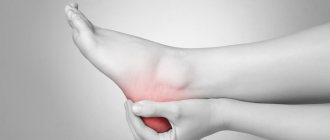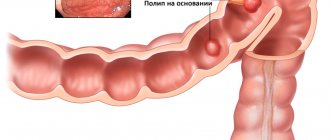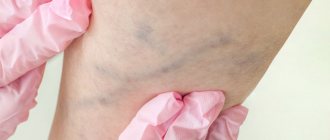A pinched nerve of the cervical spine is a pathological condition in which the nerve roots are compressed by neighboring muscle tissues, vertebrae and discs. Problems of this kind are not uncommon, and pain symptoms are more pronounced than with such a disorder in other areas.
The disease can affect people of any age and both sexes, but older people are diagnosed more often, especially if they suffer from concomitant diseases of neurological structures.
Structure of the cervical spine
The cervical spine consists of 7 parts that differ in structure from the rest. The vertebrae of the cervical region are identical, have an arched body and spinous formations. Nerves and blood vessels are located under the arch.
The two upper parts - the atlas and the axial - allow a person to turn his head. A person’s ability to lead normal life activities largely depends on them.
Structure of the cervical spine
The vertebrae located in the cervical region are in close contact with each other, separated by cartilage tissue - discs. If the physical properties of the cartilage are impaired, then a person may experience a pinched nerve, manifested by pain.
Causes
Pinching of cervical vessels can occur for a number of reasons, including the following:
- hernias,
- injuries,
- spondyloarthrosis,
- tumors.
But most often the cause of infringement is osteochondrosis. This pathology is so common that doctors call it a kind of payment for a person for walking on two legs, and not on four legs. That is, the human muscular corset is forced to constantly maintain the spine in a straight, anatomically correct position, and if the muscles are poorly developed, osteochondrosis will certainly make itself felt. At the same time, the muscles in the cervical spine are naturally weakly developed, and they bear a large load.
The psycho-emotional state of a person also has an impact: with chronic stress, the tone of the neck muscles increases, which significantly increases the risk of pinched blood vessels, the formation of a local inflammatory process and swelling that impedes blood circulation.
The most common cause of pinched vertebral artery is degenerative-dystrophic lesions of the cervical spine
What is a pinched nerve?
A pinched nerve is the appearance of any formations that put pressure on the nerve processes of the spinal cord. Pathology can be caused by multiple factors that appear both as a result of mechanical stress on the neck and naturally as a result of other diseases of the spine.
Location of the spinal cord nerve roots in the spine
Each cervical vertebra forms an arch in which threads of nerves extending from the brain stretch - the spinal cord. It can be compared to a tree trunk, from which branches extend - nerve transmitters that provide communication between parts of the body and the brain.
If there is a compressive effect on the trunk, the parts located along the branch will suffer.
Causes of a pinched nerve in the neck
A pinched nerve in the neck is caused by compression from discs, vertebrae, or nearby muscle tissue.
This happens as a result:
- accidents, neck injuries, birth trauma in infants;
- malignant tumors and benign formations;
- spasm of the neck muscles due to various factors;
- osteochondrosis and protrusions, depletion of cartilage tissue, vertebral displacement, spondylosis, intervertebral hernia or curvature of the spine;
- stenosis and aneurysms of blood vessels;
- narrowing of the foraminal canal;
- sedentary lifestyle , physical fatigue and frequent stress, high weight, hypothermia, pregnancy, the neck can blow;
- heredity, disruption of the endocrine system.
Pinched nerve
Causes of a pinched cervical nerve in a child
In infants, the cervical spine is one of the weak points as the muscles are not developed properly. Pregnant women may also experience dizziness, a symptom of a pinched nerve in the neck due to tension and increased stress on the vertebrae of the neck.
A pinched nerve in the neck can occur in children for several reasons:
- incorrect presentation in the womb;
- umbilical cord entwined around the neck;
- hydrocephalus;
- narrow pelvis and large fetal size;
- diabetic fetopathy;
- pressure on the fetus from the abdominal organs.
Pathology can be determined by the following signs:
- baby's tearfulness;
- anxiety;
- screaming when moving, swaddling, or being picked up;
- torticollis or lumps in the neck;
- muscle tension in the back of the head.
At an older age, the cause of the disorder may be injury, incorrect posture, or an uncomfortable school bag.
This pathology can lead to ischemic stroke, in which blood flow is disrupted and brain cells gradually die. The patient feels throbbing headaches that get worse when moving the head.
Trigeminal nerve entrapment
Trigeminal nerve entrapment is an inflammation that causes disruption of the connection between the central nervous system and facial facial fibers, called Bell's palsy.
The consequences of this condition are:
- muscle paresis;
- numbness of the skin;
- loss of sensation - paralysis;
- facial asymmetry;
- partial loss of taste.
Paralysis spreads to one side, it is divided into two types. Primary develops due to hypothermia.
Secondary is a consequence of other pathological factors:
- injuries;
- infectious and colds;
- inflammatory process;
- benign formations;
- advanced diabetes mellitus;
- disturbances in the functioning of cerebral vessels;
- facial anesthesia.
In many cases, the causes of pinching may not be precisely determined, then it is necessary to undergo a full diagnosis in order to exclude potential factors that stimulate the development of the disorder.
Vagus nerve entrapment
The pathological condition of the vagus nerve can begin suddenly in a completely healthy person, even at night during sleep.
12 pairs of nerves emerge from the brain, each of which is responsible for a specific area of the body. The 10th pair is called the vagus nerve, as it is capable of transmitting signals throughout almost the entire body. And if it is damaged, many systems may be disrupted.
The causes of the disease can be:
- surgical intervention;
- diabetes;
- viral respiratory diseases;
- AIDS or HIV;
- Parkinson's disease;
- alcoholism.
Nervus vagus
Due to pinching of the vagus nerve, the following various diseases develop:
Raynaud's disease
- angioneurosis;
- neurasthenia;
- migraine;
- Meniere's disease;
- Raynaud's disease.
Muscle pain
Spasms of the muscles of the neck and upper back occur due to injuries, physical strain during the day, in particular, incorrect postures, and emotional stress. Also, muscles can spasm due to an uncomfortable pillow. This condition usually manifests itself as pain and limited neck mobility. Within 6 weeks the pain goes away. To speed up the process, it is recommended to do special exercises, as well as eliminate the cause of muscle strain, if possible.
Diagnostics
If you experience discomfort in the neck, you must first contact a qualified specialist, who will carry out diagnostic measures:
- He will conduct a survey and examination to find out when the manifestations began, what kind of pain the patient is suffering from, and in what area of the cervical spine.
- The doctor orders an x-ray for a detailed examination of the neck area.
- As an additional diagnosis, magnetic resonance imaging is prescribed, which will help visualize intervertebral hernias and protrusions.
- You can also determine whether a pinched nerve is using electromyography - an examination that determines how well the transmission of nerve impulses occurs in the cervical vertebrae.
Neck pain worsens a person’s quality of life and reduces performance, so it is impossible to leave a pinched nerve without treatment.
Cervical osteochondrosis?
Among the diseases that cause neck pain, we did not mention “cervical osteochondrosis.” This diagnosis is usually made in the countries of the former Soviet Union. In fact, all the diseases listed above are attributed to osteochondrosis.
Degenerative changes in the spine are observed in almost all people over 40 years of age, and this is absolutely no reason to call a person sick and begin active treatment. Neck pain and other symptoms should indicate a real diagnosis, after which therapy is prescribed.
When should you see a doctor for neck pain?
The main reasons for which a consultation with a neurologist is necessary:
- Strong headache;
- neck injury;
- loss of control over urination or bowel movements;
- numbness, tingling, weakness in the arms or legs;
- the pain does not go away for a week, and there is no improvement;
- when conventional painkillers do not help.
See your doctor immediately if:
- You have a fever, a headache, and your neck is so stiff that you cannot reach your chin to your chest. It could be meningitis;
- Signs of a heart attack include chest pain, rapid breathing, sweating, nausea, vomiting, and pain in the arm or jaw.
Did you have a cold neck or a pinched nerve?
After hypothermia, symptoms appear the next morning. This is due to swelling of muscle tissue that has become inflamed at rest. When you wake up and try to move your head, pinched nerves occur, causing sharp pain.
Myositis can be identified by the following symptoms:
- sharp pain when turning the head to the right and left;
- pain when pressing on the site of inflammation on the left or right, and pain when chewing food;
- one-sided manifestation of sensations;
- redness and swelling of the skin of the neck;
- when the head moves, sensations are transmitted to the shoulder blades and shoulder , frontal and temporal parts of the head, as well as the ears;
- general malaise, slight chills;
- feeling of tension in the cervical region.
A particularly strong pathological process may be accompanied by a rise in temperature and headache, which is caused by compression of the arteries by swollen tissues.
Symptoms and manifestations
When a nerve is pinched in the neck, the blood vessels are also compressed, leading to poor blood circulation. Not enough oxygen enters the central nervous system and nerve cells are damaged, causing the development of a pathological process.
You can divide the symptoms of the disease depending on the vertebra of the neck where the disorder occurred.
| Cervical vertebra number | Manifestations and symptoms |
| C 1 | Discomfort in the occipital area and cervical region. |
| C 2 | Discomfort in the back of the head, parietal part and neck. |
| C 3 | Pain and numbness in the part of the neck where inflammation develops, paralysis of the sublingual tissues, loss of taste, partial loss of speech (rare manifestations). |
| C 4 | Discomfort in the collarbone and forearm, poor tone of the muscles of the head and neck, dysfunction of the respiratory system, the appearance of hiccups, discomfort in the liver and heart (the latter are not common). |
| C 5 | Pain, numbness and weakness in the soft tissues in the shoulder area. |
| C 6 | Discomfort and loss of sensation in the upper limb - from the shoulder blade to the thumb. |
| C 7 | Pain in the hand - from the shoulder blade to the middle finger, there is rarely loss of sensitivity and tingling. |
First aid
The first step is to minimize pain. Ibuprofen and Diclofenac can be taken without a prescription from a specialist. They will relieve spasms in the vertebrae and minimize inflammatory processes in the area of the problem area. The patient should take a horizontal position. Before the specialist arrives, you should not take any action: massage your neck, do physical exercises. All this can be prescribed by a neurologist
after the examination.
First aid for a pinched nerve in the neck
It is impossible to get rid of the cause of a pinched cervical nerve on your own, so first aid is limited.
Everything you can do before the doctor arrives:
- Place the patient on the floor or other flat, hard surface.
- Give the patient a painkiller tablet.
- No other activities such as massage or gymnastics are permitted.
What should you not do if you have a pinched nerve in your neck?
The duration of treatment for a pinched cervical nerve depends on the severity of the pathology, the characteristics of the body and the qualifications of the attending physician. The sooner a person seeks help from doctors, the greater his chances of returning to a normal lifestyle and avoiding serious consequences.
If your neck is pinched, it is prohibited to:
- visiting the swimming pool;
- going to the bathhouse and steam room;
- warming up the affected area.
This is explained by the ability of such procedures to aggravate the pathological process that disrupts the transmission of signals along the nerves during an exacerbation of the disease. But it is impossible to give a definitive answer to the question; it all depends on the patient and the course of the disease in his case; you can consult a doctor.
Treatment methods for pinched nerves
Treatment of a pinched nerve in the neck requires a comprehensive approach. Using different methods of therapy simultaneously to eliminate pathology is the key to a favorable outcome of the disease. All prescriptions must be made by the attending physician.
When a cervical nerve is pinched, the muscles are in a tense state almost constantly. To treat this condition, a variety of means and an individual approach to each patient are used, this will help achieve the best possible result.
Methods included in the treatment of a pinched cervical nerve include:
- drug therapy;
- physiotherapy;
- massage;
- manual therapy;
- physiotherapy.
At the initial stage, the patient is recommended to wear a device that fixes the neck.
In severe cases, surgical intervention is resorted to, and to consolidate the result, sanatorium-resort treatment of pathology of the cervical nerves is necessary.
Drug treatment
If you experience neck pain, you should contact a neurologist or neurologist. An integral part of the treatment of a pinched nerve in the neck is drug therapy; it includes several groups of drugs.
Painkillers in tablets:
- Baralgin;
- Ketonal;
- Piroxicam.
Baralgin tablets
Ketonal
Piroxicam
Remedies for muscle spasms - muscle relaxants:
- Baclofen;
- Ditylin;
- Tizanidine.
Baclofen
Tizanidine
Ditilin
Vasodilators:
- Vinpocetine;
- Cavinton;
- Niacin.
Vinpocetine Niacin Cavinton
Warming ointments are also recommended for pinched nerves; they reduce pain and relieve inflammation, relax muscle tissue, thereby having a beneficial effect on the general well-being of the patient:
- Dimexide;
- Dolobene;
- Diclofenac.
Dimexide Dolobene
Diclofenac in gel form
If there is a painful sensation in the neck that lasts for several days, then it is necessary to use compresses with warming creams:
- Larkspur;
- Sophia;
- Apirzatron.
Larkspur
Apirzatron
Sophia
Bee venom also has this effect, but this method will have a beneficial effect only at the beginning of the disease. In the later stages, they can only worsen the inflammatory process of the cervical spine.
If there is noticeable swelling and redness at the site of inflammation, short-term application of ice is recommended.
Injections for a pinched nerve in the neck help relieve inflammation, relax muscles and reduce pain:
- Mydocalm is used twice a day intramuscularly at 100 mg. or intravenously – once a day, 100 mg;
- Tolperisone is a cheaper analogue of Mydocalm;
- Diclofenac is an anti-inflammatory, non-hormonal analgesic drug, administered intramuscularly at a dose of 75 mg. in a day.
Diclofenac in injection form
Tolperisone Diclofenac
Physiotherapy
This method is highly effective in combating pinched cervical nerves. The advantage of this type of treatment is the absence of contraindications and side symptoms, which makes it suitable for almost all patients. It can be prescribed as a preventive procedure or during an acute stage.
For diseases of the cervical vertebrae, the following procedures are prescribed:
- shock wave method;
- laser therapy;
- electrophoresis.
Massage
Massage for a pinched nerve in the cervical spine requires caution. Indications for using this method are swelling and muscle spasm. Among the contraindications, one can note the pathology of fibrous rings.
The procedure has a warming, relaxing effect, and also stimulates blood circulation. You can notice the effect after the first session. Performing a massage by a non-professional can cause displacement of the vertebrae, making a person disabled.
Spinal traction
Spinal traction is prescribed mainly for mechanical damage and neck injuries. This method is safe, easy to perform and has no serious complications. The technique is aimed at relieving spasms and relaxing the muscles of the cervical spine, reducing pain, returning the intervertebral discs to their place, and is divided into several techniques.
Vertical traction is carried out while securing the person’s torso; the head is also fixed with a special holder. A load weighing from 2 to 20 kg is attached to the belt area. The duration of the session is 20 – 40 minutes, all this time the patient remains motionless thanks to the fastenings.
Stages of the underwater procedure:
- securing a patient suffering from a pinched nerve on a special platform;
- immersing the patient in a container of water;
- tensioning belts that exert tension;
- reducing pressure on the cervical vertebrae.
Dry can be carried out using the following devices:
- Glisson's loop - traction produced by suspending a load to the skull;
- derotational – used for unilateral neck pinching;
- traction bracket - a structure attached to the head with pins;
- The Halo device is a more advanced method of neck traction that acts like a brace.
Manual therapy
This type of treatment has an analgesic effect and restores the ability to move your head. The result is noticeable after the first session, tension goes away and the muscles relax, thereby reducing the pressure on the pinched nerve.
The advantages of manual therapy are:
- improving the functioning of neurons;
- relieving neck muscle spasms;
- expansion of the space between the elements of the spine;
- restoration of blood flow.
Manual therapy not only helps relieve symptoms, but also restores the pinched nerve.
Gymnastics
To provide treatment at home, there are special gymnastics for pinched cervical nerves. Exercises and morning exercises help relieve pain, improve blood circulation, and relax muscles.
What exercises will help with pathology:
- In a lying position, inhale smoothly 20 times, then hold the air for 10 seconds, repeat several times.
- Lie on your stomach, stretch and raise your head and chest as high as possible, slowly lower, repeat 20 times.
- Turn over, bend your knees, and do body lifts alternating to the right and left sides. Do 20 repetitions.
Surgery
An extreme measure that is used in the absence of improvement from conservative treatment.
The decision to perform an operation is made by the doctor, taking into account:
- age;
- patient's well-being;
- picture of the disease.
The recovery period lasts for 1.5 – 2 months. Surgery is used for hernias that do not respond to treatment.
Treatment
Therapy for pinching consists of a whole range of measures that are aimed at restoring blood circulation to the brain, relieving symptoms and normalizing well-being, as well as eliminating the cause of the pinching.
Drug therapy
If there is inflammation and swelling in the neck muscles, which usually results in the inability to turn the head, the doctor will prescribe non-steroidal anti-inflammatory drugs. They are used both internally and externally, in the form of ointments.
Muscle relaxants help relieve muscle tension, but their effect will be temporary if you do not deal with the cause of increased muscle tone, for example, chronic stress.
Help eliminate brain symptoms:
- B vitamins;
- nootropics;
- neuroprotectors;
- vasodilators.
Each medicine has its own contraindications, so only the attending physician can prescribe them.
If the pinching was caused by a disorder in the tissues of the spine, chondroprotectors can be used. If necessary, painkillers may be prescribed.
Physiotherapy
Physiotherapeutic techniques are based on heating the soft tissues of the neck. This helps speed up the process of relieving inflammation from the muscles and reducing their tone.
The following treatment methods are used:
- electrophoresis,
- UHF therapy,
- laser,
- magnetic therapy,
- phonophoresis.
Treatment is carried out in a course, the duration of which is determined by the doctor.
Massage
A properly performed massage helps relieve neck tension and pain, as well as improve blood circulation. But only a qualified specialist can perform a massage, otherwise more damage can be caused to the body. For example, there is a risk of developing thromboembolism and stroke.
It is important that massage of the cervical-collar area is performed by a specialist with medical education
Physiotherapy
During the acute phase of the disease, doing any exercises on the neck is strictly contraindicated. On the contrary, at this time the neck should be immobilized as much as possible, which can be conveniently done using the Shants collar.
During the period of remission, it is useful to do exercises to strengthen the muscular corset of the neck. You can press your hand on the side of your head while simultaneously applying resistance with your neck muscles. Gradually and extremely carefully, you can turn your head and bend.
Swimming has great benefits.
Surgical intervention
The help of a surgeon is usually required if the pathological process is caused by a vertebral hernia or injury, after which bone fragments need to be removed. Surgeries may also be indicated for tumors.
After the operations, the patient recovers during the rehabilitation period, the duration of which can reach 8–10 weeks.
Treatment at home
If you have a pinched nerve in your neck, you can use home treatment to relieve symptoms. But before using any means, it is better to consult a doctor. Although doctors are dismissive of this method, they do not prohibit the use of funds if they do not have a negative effect.
Yet traditional medicine remains popular to this day; there are many recipes for compresses, ointments, and decoctions of medicinal plants. In combination with traditional treatment, folk recipes can have an effect.
Folk remedies
If a nerve is pinched in the neck, the following folk remedies can help relieve symptoms:
- compresses of horseradish leaves to the site of inflammation and wrap with a cloth, leave until the morning. Several techniques will help get rid of pain and eliminate spasms of muscle tissue.
- Take fir oil and valerian in equal proportions and mix thoroughly. Apply the resulting ointment to the localized inflammation.
- the mountain wax in a water bath, pour into a container with a flat bottom, wait until it hardens, then apply to the sore area of the neck overnight, wrap with a cloth. High blood pressure is a contraindication.
- Bath with healing plants . Prepare a decoction of chamomile, nettle, oak bark, and spruce. Add 1 liter of decoction for every 15 liters of water.
It is important not to rely entirely on such therapy; it is necessary to follow the doctor’s recommendations, take pills, use ointments, and undergo physiotherapeutic procedures.
Driving with a pinched nerve
It is possible to drive a car if the cervical nerve is pinched, but doctors still advise refraining from doing so until remission occurs. Prolonged driving tires a person and aggravates spinal diseases.
While in the car, the driver sits in an uncomfortable position, which puts stress on the intervertebral discs, which increases with shaking.
When choosing a car, you should focus not only on driving capabilities, but also choose a comfortable seat:
- It should be equipped with a lumbar support mechanism.
- A movable back that follows the shape of the spine.
- A headrest that makes it easier to control.
If you have a spinal disease and to prevent it, you need to take a break and get out of the car every 2 to 3 hours.
